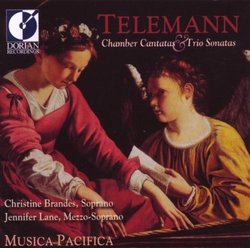| All Artists: Georg Philipp Telemann, Christine Brandes, Jennifer Lane, Musica Pacifica, Linsenberg, Blumenstock Title: Telemann - Chamber Cantatas & Trio Sonatas / Brandes · Lane · Musica Pacifica Members Wishing: 0 Total Copies: 0 Label: Dorian Recordings Original Release Date: 1/1/2001 Re-Release Date: 10/2/2001 Genres: Pop, Classical Styles: Vocal Pop, Opera & Classical Vocal, Chamber Music, Historical Periods, Baroque (c.1600-1750), Classical (c.1770-1830) Number of Discs: 1 SwapaCD Credits: 1 UPC: 053479323927 |
Search - Georg Philipp Telemann, Christine Brandes, Jennifer Lane :: Telemann - Chamber Cantatas & Trio Sonatas / Brandes · Lane · Musica Pacifica
 | Georg Philipp Telemann, Christine Brandes, Jennifer Lane Telemann - Chamber Cantatas & Trio Sonatas / Brandes · Lane · Musica Pacifica Genres: Pop, Classical
|
Larger Image |
CD Details |
CD ReviewsPerfect Fit Giordano Bruno | Wherever I am, I am. | 06/18/2008 (5 out of 5 stars) "Georg Philipp Telemann was one of the most prolific composers of all time, producing more in his 86 years even than Haydn in his equally long life. Just to select the right pieces out of such a plethora of music is proof of understanding. Musica Pacifica has done it, chosen a program that perfectly suites their ensemble skills. The five cantatas and two sonatas on this CD are all rare gems, performed with rare skill and insight.
During his 46 years in Hamburg (1721-1767), Telemann had the task of supplying music for the city's five principal churches, including two cantatas every Sunday of the liturgical year. The second cantatas, performed after the sermons, were shorter and required fewer voices and instruments. In 1725, Telemann offered for sale, by subscription, an entire year's cycle of such cantatas, designed to be accessible to all congregations and performable with a minimum of forces. Most of them are solo cantatas - two arias and a recitativo - with one melodic instrument plus continuo. Substitution of instruments was a common practice of the times. The subscription must have been successful, since Telemann issued another cycle in 1731, calling for two melodic instruments and slightly more demanding vocal technique. Singers Christine Brandes and Jennifer Lane are both fully capable of meeting the most virtuosic demands of Baroque opera and oratorio. Here, however, they have a different challenge, to make relatively simple music exquisitely interesting. They do it by maximizing the expressive timbres of their voices. In the same spirit, Brandes's more exultant soprano is paired with Judith Linsenberg's aerial alto recorder on two cantatas expressing scorn for human vanity, while Lane's eloquent mezzo is matched with the darker string timbres of Elizabeth Bluemenstock's violin and David Morris's cello on two cantatas of consolation. The fifth cantata - Erwag, O Mensch - is taken from Telemann's later, more elaborate cycle. It's sung by Ms. Brandes with both violin and recorder obbligato, though at times all three 'trebles' interact as melodic equals in a canonic trio. The text is a poem of thanksgiving for the blessing of the Sabbath, the day of rest and, by implication, musical recreation. Brandes does a superb job of matching her tone and articulation to her instrumental partners. The recorder Judith Linsenberg plays on Erwag, O Mensch is not the standard alto recorder in F favored by most Baroque composers, but rather a lower-pitched recorder in D, called a voice flute for good reason, since its range and timbre are remarkably close to the human soprano voice. Linsenberg also plays the voice flute on the two sonatas from Telemann's collection titled "Sonates Corellisantes" - Corelli-izing Sonatas - the German composer's tribute to the universal popularity of the Italian composer's manner. The voice flute might easily be overwhelmed by the more powerful violin, but Linsenberg and Blumenstock "play into each other" with sympathetic aplomb. Lutenist Michael Egan and keyboardist Byron Schenkman provide equally sympathetic continuo. Musica Pacifica shows what the word "ensemble" really means, playing this delicate repertoire with the kind of 'togetherness' one expects of long-time musical colleagues. All in all, this is as polished and delightful a concert of Baroque chamber music as anyone could hope for." |

 Track Listings (24) - Disc #1
Track Listings (24) - Disc #1